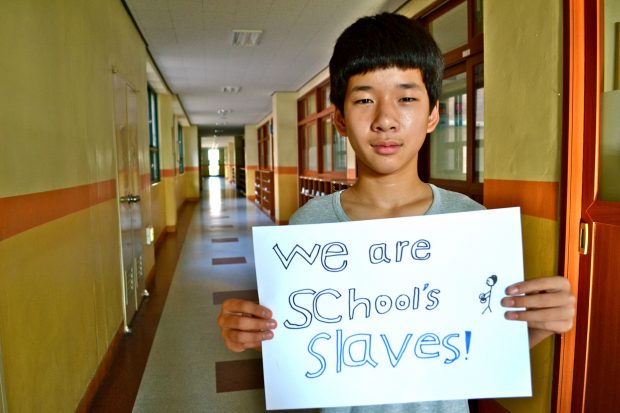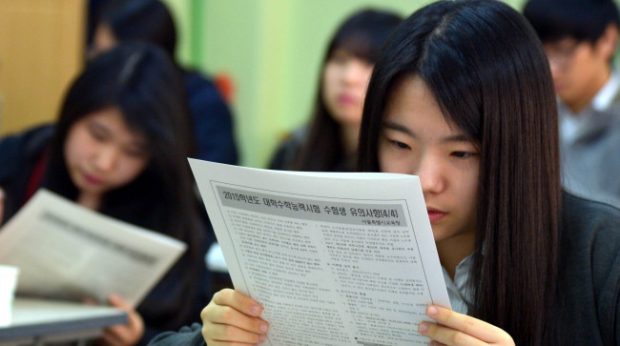The Dark Side of the Korean Education System and New Purposes for the Future

Suneung, the most important test of your life
The Korean school system is based on six years of elementary school (age 6-12), three years of junior high school (age 12-15) and three years of senior high school (15-18).
What comes next is apparently the most important stage in life: the University entrance exam. South Korea falls silent every second Tuesday of each November: heavy trucks banned from the streets, businesses opening late in order to free the roads, delayed flights so that students can focus without distractions. Moreover, anyone running late to the exam site can ask for a free police escort to rush them straight to the destination. Parents usually pray in various religious gatherings where special sessions are held for the students. Suneung, the college entrance exam that takes place once every year, defines the future of these people. In a hierarchical country such as South Korea, the University one has attended is essential in finding a suitable job and consequently, a well-to-do position in society. Daniel Tudor, a former Economist correspondent in South Korea and author of “Korea: The Impossible Country” said regarding the Korean education system, “There is this sense that, ‘Oh, you are going to fail at life unless you do well in this exam’”.
Teenage suicide
The pressure to score well on the exam has been blamed as the cause of teenage depression and suicide rates that are among the
highest in the world. According to the report by Statistics Korea, suicide was the leading cause of death among those aged 9-24 in 2013. The reasons behind teenage suicides were: school admission (39.2%), family troubles (16.9%), financial difficulties (16.7%), and loneliness (12.5%).

Korean students are not satisfied with their life because of the enormous amount of pressure they receive from studying. In fact, the competitive system of the country affects people of all ages: according to a 2017 study that appeared on The Korea Herald, South Korea ranked 33rd out of 34 countries surveyed on national happiness despite improvements in welfare. South Koreans’ satisfaction with life came at 27th and the suicide rate remained at the bottom.
Hagwons and private tutors
In order to prepare their children for the University test, South Korean parents spend thousands of dollars a year on after-school tuition, which is private-schooling on an industrial scale. From Monday to Friday children usually attend school and have self-study sessions in the afternoon. In middle school, students begin having concentrated afterschool courses in hagwons (private academies). 75 percent of all children attend the 100,000 hagwons that are all over South Korea. Officially, these academies are banned from operating beyond 10 p.m. and suspicion of prolonged classes can result in raids by special inspectors. High school teenagers usually have private tutors who will teach them in their homes after hagwon classes, oftentimes, very late into the night. As a result, students who have more chances to get into the best schools are the ones with the richest parents who can afford extra money for private lessons and tutors. The high price for the education is also one of the reasons for the low birth rate in South Korea.
Nowadays, there is this common idea that entering a certain kindergarten can make the difference for the future because it affects the selection of the elementary school, the middle school, and ultimately, University. For these reasons, family expenditure on education has helped push household debts.
Memorization is not intelligence
The amount of hours invested in academia has great results. In fact, according to the PISA Test of 2015 (a triennial international survey which aims to evaluate education systems worldwide by testing the skills and knowledge of 15-year-old students), South Korea ranked first in math, third in reading, and fifth in science aptitude among the OECD member states.
Korea’s generally memory-based education can be useful for the PISA test but it is not enough for maintaining competitiveness at the global level. In fact, academic knowledge is only one of the skills required. Communication, collaboration, and creativity are also important attributes which Korean students do not necessarily exhibit.
Hope for the future
Recently, however, the Korean government acknowledged all the issues of the Korean school system and is bent on making improvements. In fact, on March 30th 2017, at Seoul Office of Education, a special lecture was given by Cho Hee-yeon, Superintendent of Education. He explained the features of the current school system noting its authoritarian and hierarchical paradigm based on rote memorization of knowledge and high results. Consequently, the goal is to reform the current system introducing a democratic system based on creativity, education equality, and only-one education (each student is different and should be evaluated according to different criteria). Mr. Cho also mentioned collaboration with parents with the creation of a parents’ association in each school seeing how Korean relatives are very involved in their children’s education.
Hopefully, these new proposals will be implemented soon because the current Korean system does not take into account the needs children of all ages. It is common sense that happiness and self-confidence are important for human well-being and for job satisfaction.
-Alessandra Bonanomi, reporter for The AsiaN

























































In Bangladesh we are facing same sort of problem